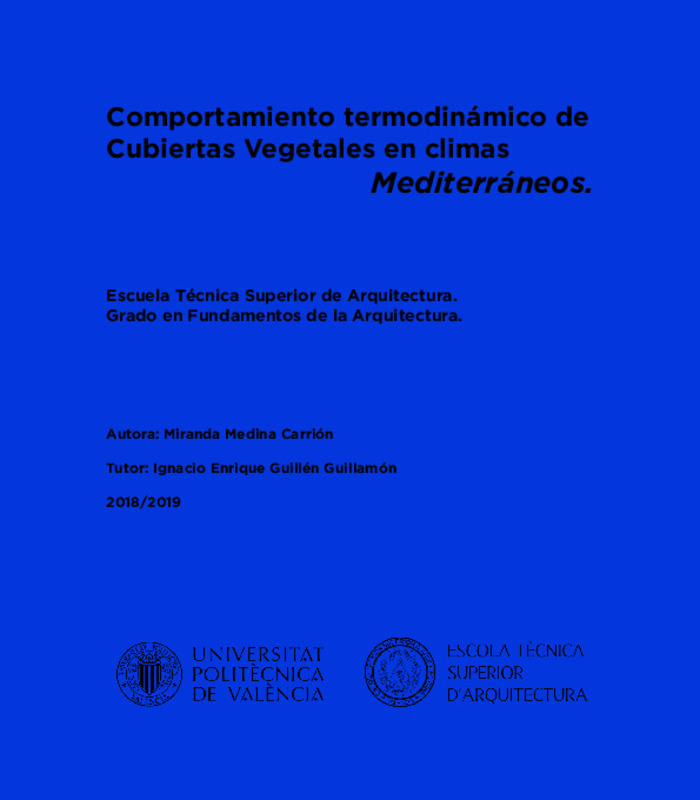JavaScript is disabled for your browser. Some features of this site may not work without it.
Buscar en RiuNet
Listar
Mi cuenta
Estadísticas
Ayuda RiuNet
Admin. UPV
Comportamiento termodinámico de cubiertas vegetales en climas mediterraneos
Mostrar el registro sencillo del ítem
Ficheros en el ítem
| dc.contributor.advisor | Guillén Guillamón, Ignacio Enrique
|
es_ES |
| dc.contributor.author | Medina Carrión, Miranda
|
es_ES |
| dc.date.accessioned | 2020-01-20T13:21:11Z | |
| dc.date.available | 2020-01-20T13:21:11Z | |
| dc.date.created | 2019-09-19 | |
| dc.date.issued | 2020-01-20 | es_ES |
| dc.identifier.uri | http://hdl.handle.net/10251/135216 | |
| dc.description.abstract | [ES] La construcción de cubiertas vegetales y su desarrollo no son de reciente creación, sin embargo, aumenta en estos últimos años el interés en este tipo de propuestas, debido a la importancia que tienen en aspectos ambientales y energéticos. Se expone inicialmente en este documento las diversas variedades que existen de cubiertas vegetales. A continuación, se elige una variedad concreta a la que se cambian diferentes variables y se observa el comportamiento que tiene en función de los códigos establecidos para la eficiencia energética. Si estas cubiertas están compuestas básicamente de una base resistente, de material aislante y del sustrato junto con el manto vegetal, las variables con las que se lleva a cabo el estudio son la capa de aislamiento y la capa de sustrato, independientemente del resto de capas. Se obtienen distintos resultados aumentando o disminuyendo el espesor de las capas que componen la cubierta. Por otra parte, para el estudio del comportamiento energético de esta cubierta, se aplican otras variables que dependen del ambiente exterior que rodea el edificio. Se compara su comportamiento dependiendo de su situación geográfica, tanto con el clima Mediterráneo de costa de la ciudad de València, como con el clima Mediterráneo de zonas del interior, como por ejemplo, la ciudad de Cuenca. Este comportamiento energético con respecto a las diferentes combinaciones de variables, se obtiene interpretando los cálculos resultantes con el programa informático oficial del Código Técnico de la Edificación para certificación de la Eficiencia Energética, HULC. Así, se sabe si se ha obtenido una solución de cubierta vegetal eficiente o no. Una vez se obtienen los resultados, para saber si las cubiertas vegetales son lo suficientemente competitivas en el ámbito de la energía y de las cubiertas planas en general, se comparan los resultados con un Caso Ø de cubierta plana tradicional (sin ser vegetal) que cumple todos los requisitos del Código Técnico de la Edificación. Finalmente, se compara entre todas las variables y cubiertas (vegetal y convencional) para obtener información sobre los efectos de las cubiertas vegetales en la eficiencia energética de los edificios y su contribución a la sostenibilidad de la edificación. | es_ES |
| dc.description.abstract | [EN] The construction of vegetal covers and its development is not of recent creation. However, interest on this kind of proposals has risen in the last years due to their importance in environmental and energetic aspects. Firstly, this document exposes the different varieties that exist of vegetal covers. Next, a specific variety to which different variables are modified is chosen, and its behaviour according to the stablished codes for the energetic efficiency is observed. If these covers are composed basically by a resistant basis, of insulating material and of substrate with the vegetal mantle, the variables the study is accomplished with are the insulating layer and the substrate one, regardless the rest of the layers. Different results are obtained, increasing or reducing the thickness of the layers that compose the cover. On the other hand, for the study of the energetic behaviour of this cover, other variables that depend on the exterior environment that surrounds the building have been applied. Its behaviour is been compared depending on its geographic situation, both in the Mediterranean coast climate of the city of Valencia and in inland Mediterranean climates such as the one in the city of Cuenca. This energetic behaviour with regards to the different combination of varieties is obtained reading the resulting calculations with the official informatic program of the Technical Building Code for the certification of the Energetic Efficiency, HULC. Thus, it is known if an efficient or non-efficient solution of vegetal cover has been obtained. In order to know if the vegetal covers are competitive enough in the field of energy and of flat covers in general, once obtained the results, they are compared with a Ø case of a traditional flat cover (not being vegetal) that fulfils all the requirements of the Technical Building Code. Finally, all the variables and covers (vegetal and conventional) are compared to obtain information about the effects of vegetal covers in the energetic efficiency of the buildings and its contribution to sustainability in construction. | en_EN |
| dc.language | Español | es_ES |
| dc.publisher | Universitat Politècnica de València | es_ES |
| dc.rights | Reconocimiento - No comercial (by-nc) | es_ES |
| dc.subject | Eficiencia Energética | es_ES |
| dc.subject | Cubiertas vegetales | es_ES |
| dc.subject | Simulación | es_ES |
| dc.subject | Sostenibilidad | es_ES |
| dc.subject | Climas Mediterráneos | es_ES |
| dc.subject | Energy efficiency | en_EN |
| dc.subject | Green roofs | en_EN |
| dc.subject | Building simulation | en_EN |
| dc.subject | Sustainability | en_EN |
| dc.subject | Mediterranean climates | en_EN |
| dc.subject.classification | FISICA APLICADA | es_ES |
| dc.subject.other | Grado en Fundamentos de la Arquitectura-Grau en Fonaments de l'Arquitectura | es_ES |
| dc.title | Comportamiento termodinámico de cubiertas vegetales en climas mediterraneos | es_ES |
| dc.type | Proyecto/Trabajo fin de carrera/grado | es_ES |
| dc.rights.accessRights | Abierto | es_ES |
| dc.description.bibliographicCitation | Medina Carrión, M. (2019). Comportamiento termodinámico de cubiertas vegetales en climas mediterraneos. http://hdl.handle.net/10251/135216 | es_ES |
| dc.description.accrualMethod | TFGM | es_ES |
| dc.relation.pasarela | TFGM\111111 | es_ES |
Este ítem aparece en la(s) siguiente(s) colección(ones)
-
ETSA - Trabajos académicos [4687]
Escuela Técnica Superior de Arquitectura







